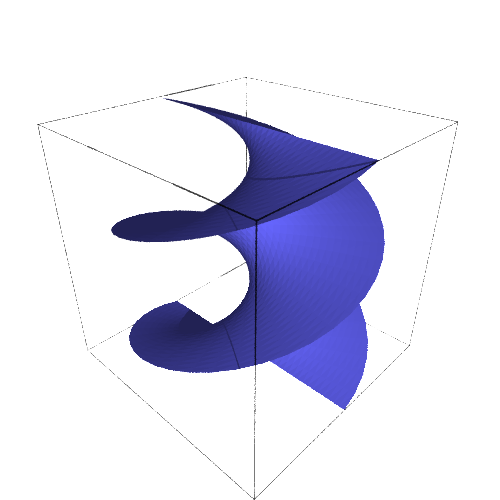In here, it is seen that the curvature of a unit speed parametric curve $\alpha(t)$ in $\mathbb{R}^3$ can be measured by its acceleration $\ddot\alpha(t)$. In this case, the acceleration happens to be a normal vector field along the curve. Now we turn our attention to surfaces in Euclidean 3-space $\mathbb{R}^3$ and we would like to devise a way to measure the bending of a surface in $\mathbb{R}^3$, and it may be achieved by studying the change of a unit normal vector field on the surface. To study the change of a unit normal vector field on a surface, we need to be able to differentiate vector fields. But first let us review the directional derivative you learned in mutilvariable calculus. Let $f:\mathbb{R}^3\longrightarrow\mathbb{R}$ be a differentiable function and $\mathbf{v}$ a tangent vector to $\mathbb{R}^3$ at $\mathbf{p}$. Then the directional derivative of $f$ in the $\mathbf{v}$ direction at $\mathbf{p}$ is defined by
\begin{equation}
\label{eq:directderiv}
\nabla_{\mathbf{v}}f=\left.\frac{d}{dt}f(\mathbf{p}+t\mathbf{v})\right|_{t=0}.
\end{equation}
By chain rule, the directional derivative can be written as
\begin{equation}
\label{eq:directderiv2}
\nabla_{\mathbf{v}}f=\nabla f(\mathbf{p})\cdot\mathbf{v},
\end{equation}
where $\nabla f$ denotes the gradient of $f$
$$\nabla f=\frac{\partial f}{\partial x_1}E_1(\mathbf{p})+\frac{\partial f}{\partial x_2}E_2(\mathbf{p})+\frac{\partial f}{\partial x_3}E_3(\mathbf{p}),$$
where $E_1, E_2, E_3$ denote the standard orthonormal frame in $\mathbb{R}^3$. The directional derivative satisfies the following properties.
Theorem. Let $f,g$ be real-valued differentiable functions on $\mathbb{R}^3$, $\mathbf{v},\mathbf{w}$ tangent vectors to $\mathbb{R}^3$ at $\mathbf{p}$, and $a,b\in\mathbb{R}$. Then
- $\nabla_{a\mathbf{v}+b\mathbf{w}}f=a\nabla_{\mathbf{v}}f+b\nabla_{\mathbf{w}}f$
- $\nabla_{\mathbf{v}}(af+bg)=a\nabla_{\mathbf{v}}f+b\nabla_{\mathbf{v}}g$
- $\nabla_{\mathbf{v}}fg=(\nabla_{\mathbf{v}}f)g(\mathbf{p})+f(\mathbf{p})\nabla_{\mathbf{v}}g$
The properties 1 and 2 are linearity and the property 3 is Leibniz rule. The directional derivative \eqref{eq:directderiv} can be generalized to the covariant derivative $\nabla_{\mathbf{v}}X$ of a vector field $X$ in the direction of a tangent vector $\mathbf{v}$ at $\mathbf{p}$:
\begin{equation}
\label{eq:covderiv}
\nabla_{\mathbf{v}}X=\left.\frac{d}{dt}X(\mathbf{p}+t\mathbf{v})\right|_{t=0}.
\end{equation}
Let $X=x_1E_1+x_2E_2+x_2E_3$ in terms of the standard orthonormal frame $E_1,E_2,E_3$. Then $\nabla_{\mathbf{v}}X$ can be written as
\begin{equation}
\label{eq:covderiv2}
\nabla_{\mathbf{v}}X=\sum_{j=1}^3\nabla_{\mathbf{v}}x_jE_j.
\end{equation}
Here, $\nabla_{\mathbf{v}}x_j$ is the directional derivative of the $j$-th component function of the vector field $X$ in the $\mathbf{v}$ direction as defined in \eqref{eq:directderiv}. The covariant derivative satisfies the following properties.
Theorem. Let $X,Y$ be vector fields on $\mathbb{R}^3$, $\mathbf{v},\mathbf{w}$ tangent vectors at $\mathbf{p}$, $f$ a real-valued function on $\mathbb{R}^3$, and $a,b$ scalars. Then
- $\nabla_{\mathbf{v}}(aX+bY)=a\nabla_{\mathbf{v}}X+b\nabla_{\mathbf{v}}Y$
- $\nabla_{a\mathbf{v}+b\mathbf{w}}X=a\nabla_{\mathbf{v}}X+b\nabla_{\mathbf{v}}X$
- $\nabla_{\mathbf{v}}(fX)=(\nabla_{\mathbf{v}}f)X(\mathbf{p})+f(\mathbf{p})\nabla_{\mathbf{v}}X$
- $\nabla_{\mathbf{v}}(X\cdot Y)=(\nabla_{\mathbf{v}}X)\cdot Y+X\cdot\nabla_{\mathbf{v}}Y$
The properties 1 and 2 are linearity and the properties 3 and 4 are Leibniz rules.
Hereafter, I assume that surfaces are orientable and have nonvanishing normal vector fields. Let $\mathcal{M}\subset\mathbb{R}^3$ be a surface and $p\in\mathcal{M}$. For each $\mathbf{v}\in T_p\mathcal{M}$, define
\begin{equation}
\label{eq:shape}
S_p(\mathbf{v})=-\nabla_{\mathbf{v}}N,
\end{equation}
where $N$ is a unit normal vector field on a neighborhood of $p\in\mathcal{M}$. Since $N\cdot N=1$, $(\nabla_{\mathbf{v}}N)\cdot N=-2S_p(\mathbf{v})\cdot N=0$. This means that $S_p(\mathbf{v})\in T_p\mathcal{M}$. Thus, \eqref{eq:shape} defines a linear map $S_p: T_p\mathcal M\longrightarrow T_p\mathcal{M}$. $S_p$ is called the shape operator of $\mathcal{M}$ at $p$ (derived from $N$).For each $p\in\mathcal{M}$, $S_p$ is a symmetric operator, i.e.,
$$\langle S_p(\mathbf{v}),\mathbf{w}\rangle=\langle S_p(\mathbf{w}),\mathbf{v}\rangle$$
for any $\mathbf{v},\mathbf{w}\in T_p\mathcal{M}$.
Let us assume that $\mathcal{M}\subset\mathbb{R}^3$ is a regular surface so that any differentiable curve $\alpha: (-\epsilon,\epsilon)\longrightarrow\mathcal{M}$ is a regular curve, i.e., $\dot\alpha(t)\ne 0$ for every $t\in(-\epsilon,\epsilon)$. If $\alpha$ is a differentiable curve in $\mathcal{M}\subset\mathbb{R}^3$, then
\begin{equation}
\label{eq:acceleration}
\langle\ddot\alpha,N\rangle=\langle S(\dot\alpha),\dot\alpha\rangle.
\end{equation}
$\langle\ddot\alpha,N\rangle$ is the normal component of the acceleration $\ddot\alpha$ to the surface $\mathcal{M}$. \eqref{eq:acceleration} says the normal component of $\ddot\alpha$ depends only on the shape operator $S$ and the velocity $\dot\alpha$. If $\alpha$ is represented by arc-length, i.e., $|\dot\alpha|=1$, then we get a measurement of the way $\mathcal{M}$ is bent in the $\dot\alpha$ direction. Hence we have the following definition:
Definition. Let $\mathbf{u}$ be a unit tangent vector to $\mathcal{M}\subset\mathbb{R}^3$ at $p$. Then the number $\kappa(\mathbf{u})=\langle S(\mathbf{u}),\mathbf{u}\rangle$ is called the normal curvature of $\mathcal{M}$ in $\mathbf{u}$ direction. The normal curvature $\kappa$ can be considered as a continuous function on the unit circle $\kappa: S^1\longrightarrow\mathbb{R}$. Since $S^1$ is compact (closed and bounded), $\kappa$ attains a maximum and a minimum values, say $\kappa_1$, $\kappa_2$, respectively. $\kappa_1$, $\kappa_2$ are called the principal curvatures of $\mathcal{M}$ at $p$. The principal curvatures $\kappa_1$, $\kappa_2$ are the eigenvalues of the shape operator $S$ and $S$ can be written as the $2\times 2$ matrix
\begin{equation}
\label{eq:shape2}
S=\begin{pmatrix}
\kappa_1 & 0\\
0 & \kappa_2
\end{pmatrix}.
\end{equation}
The arithmetic mean $H$ and the squared Gau{\ss}ian mean $K$ of $\kappa_1$, $\kappa_2$
\begin{align}
\label{eq:mean}
H&=\frac{\kappa_1+\kappa_2}{2}=\frac{1}{2}\mathrm{tr}S,\\
\label{eq:gauss}
K&=\kappa_1\kappa_2=\det S
\end{align}
are called, respectively, the mean and the Gaußian curvatures of $\mathcal{M}$. The definitions \eqref{eq:mean} and \eqref{eq:gauss} themselves however are not much helpful for calculating the mean and the Gaußian curvatures of a surface. We can compute the mean and the Gaußian curvatures of a parametric regular surface $\varphi: D(u,v)\longrightarrow\mathbb{R}^3$ using Gauß’ celebrated formulas
\begin{align}
\label{eq:mean2}
H&=\frac{G\ell+En-2Fm}{2(EG-F^2)},\\
\label{eq:gauss2}
K&=\frac{\ell n-m^2}{EG-F^2},
\end{align}
where
\begin{align*}
E&=\langle\varphi_u,\varphi_u\rangle,\ F=\langle\varphi_u,\varphi_v\rangle,\ G=\langle\varphi_v,\varphi_v\rangle,\\
\ell&=\langle N,\varphi_{uu}\rangle,\ m=\langle N,\varphi_{uv}\rangle,\ n=\langle N,\varphi_{vv}\rangle.
\end{align*}
It is straightforward to verify that
\begin{equation}
\label{eq:normal}
|\varphi_u\times\varphi_v|^2=EG-F^2.
\end{equation}
Example. Compute the Gaußian and the mean curvatures of helicoid
$$\varphi(u,v)=(u\cos v,u\sin v, bv),\ b\ne 0.$$
Solution. \begin{align*}
\varphi_u&=(\cos v,\sin v,0),\ \varphi_v=(-u\sin v,u\cos v,b),\\
\varphi_{uu}&=0,\ \varphi_{uv}=(-\sin v,\cos v,0),\ \varphi_{vv}=(-u\cos v,-u\sin v,0).
\end{align*}
$E$, $F$ and $G$ are calculated to be
$$E=1,\ F=0,\ G=b^2+u^2.$$
$\varphi_u\times\varphi_v=(b\sin v,-b\cos v,u)$, so the unit normal vector field $N$ is given by
$$N=\frac{\varphi_u\times\varphi_v}{\sqrt{EG-F^2}}=\frac{(b\sin v,-b\cos v,u)}{\sqrt{b^2+u^2}}.$$
Next, $\ell, m,n$ are calculated to be
$$\ell=0,\ m=-\frac{b}{\sqrt{b^2+u^2}},\ n=0.$$
Finally we find the Gaußian curvature $K$ and the mean curvature $H$:
\begin{align*}
K&=\frac{\ell n-m^2}{EG-F^2}=-\frac{b^2}{(b^2+u^2)^2},\\
H&=\frac{G\ell+En-2Fm}{2(EG-F^2)}=0.
\end{align*}
Surfaces with $H=0$ are called minimal surfaces.
For further reading on the topic I discussed here, I recommend:
Barrett O’Neil, Elementary Differential Geometry, Academic Press, 1967


good work